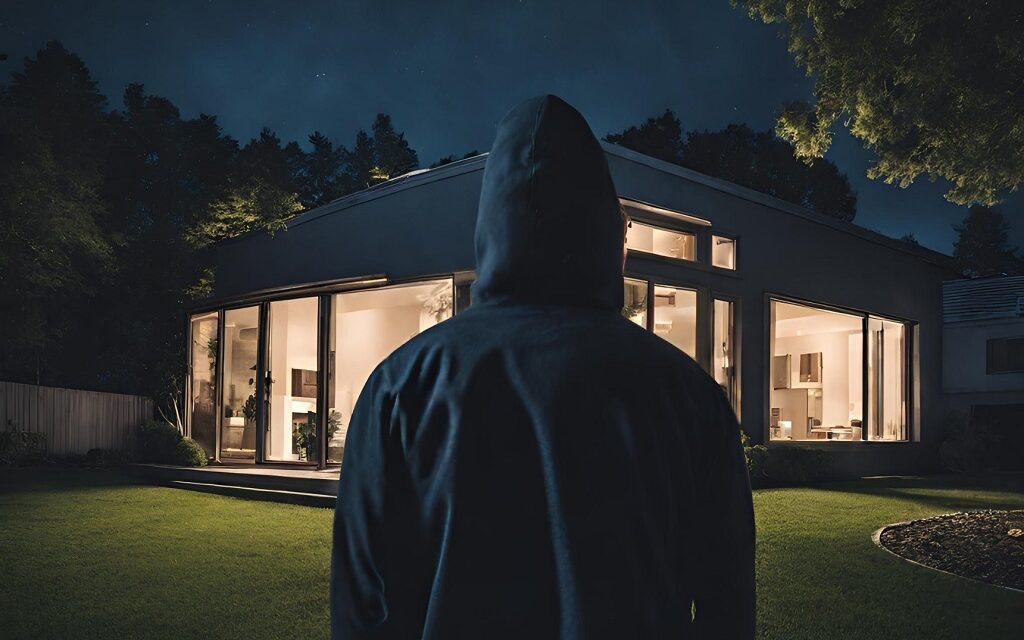Your home should be a safe haven, a place where you should always feel safe, secure and protected. However, are you familiar with phrogging, yet another potential threat to the sanctity of your home?
Phrogging is a creepy, surreptitious form of house squatting that happens concurrently within a household occupied by legal residents.
This type of home invasion involves uninvited strangers (AKA phroggers or phrogs) who secretly take over portions of your personal space, without your permission or knowledge. In short, phroggers sneak into your home, undetected, and use it as their own living space.
It’s a growing concern within home security, especially for homeowners that spend considerable time away from their primary or secondary residences, as well as remote landlords (sometimes derogatorily referred to as absentee landlords). In this article, we explore everything you need to know about phrogging – from how it occurs to signs that your property may be at risk.
We also share tips on how to protect your home from these invisible intruders, including conducting regular security checks and installing security cameras and alarms. Lastly, we’ll talk about the legal recourse available for victims of phrogging and answer some frequently asked questions about this disturbing phenomenon.
Table of Contents
- The Growing Threat of Phrogging
- How Phrogging Differs from House Squatting
- How Phrogging Happens
- Phrogging Trends
- Signs that Your Home May Be at Risk of Being Phrogged
- How to Protect Your Home from Phrogging Intruders
- Legal Recourse for Victims of Phrogging
- Frequently Asked Questions about Phrogging
- Phrogging Videos
- Closing Comments
Also see:
- How to Protect Yourself During Service Calls in Your Home
- How to Avoid the Most Common Homeowner Scams
- How to Prevent Homeowner Targeted Identity Theft
- More Recommended Homeowner Security & Consumer Protection Articles
- Related Topics: Protection & Safety | Consumer Rights | Home Inspections | Hiring Contractors
The Growing Threat of Phrogging
Though phrogging is still considered to be a rare event, public awareness of this eerie threat has significantly increased in recent years largely due to noteworthy entertainment offerings. Programs and movies such, as a new Lifetime documentary series, a truelife miniseries by Netflix, and an Oscar-winning Korean thriller have resonated with viewers by striking a chord of doubt in terms of feeling safe in one’s own home.
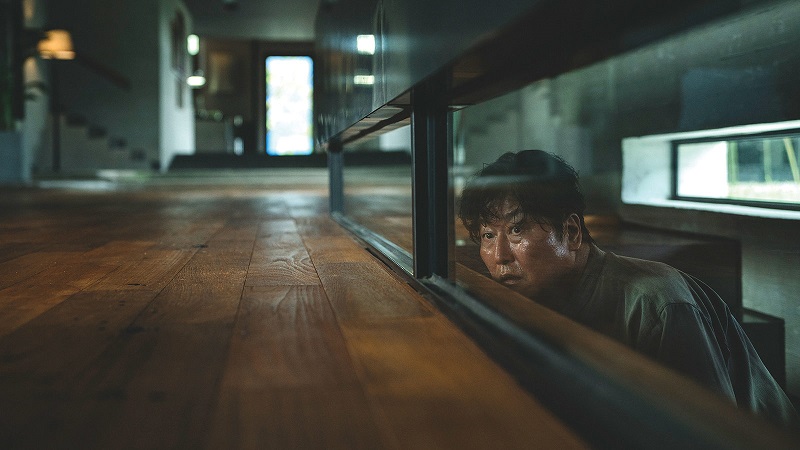
A scene from the Oscar-winning Korean movie Parasite
First and foremost, phrogging is a form of home invasion. Home invasion is a serious threat to your safety and privacy, and phrogging, in particular, can instill severe mental anxiety and fear in victims. Phrogs take advantage of vacant, unmonitored spaces in your home to gain unauthorized access, putting you and your loved ones at risk.
Though it may seem implausible that any homeowner would be unable to detect a freeloading “tenant” in one’s home, it becomes more plausible when broadening the scope and definition of “phrogging”.
For example, instances of a “short-term house squatter” are occurring when a home invader temporarily lives in a property while the legal homeowners or tenants are away on extended trips or are temporarily relocated (e.g. consulting assignment, hospitalization, emergency trip out of state). Since the home is technically not vacant, this type of crime can be classified as phrogging.
Here are three additional reasons why all homeowners will want to be knowledgeable on this topic, no matter how rare this phenomenon may be:
Virtual Phrogging
Unfortunately, we envision that phrogging, in all its many forms, will impact increasing numbers of lives and households in coming years largely due to invasive technology. In other words, technology’s ever-growing tentacles of cloaked access and control will continue to enable criminals to invade the lives of others virtually. We refer to this type of technology-powered crime as Virtual Phrogging.
Look for “virtual phrogging” to become a “thing”, even though at the time of this article’s original publishing date Google returned “0” results for this nascent term.
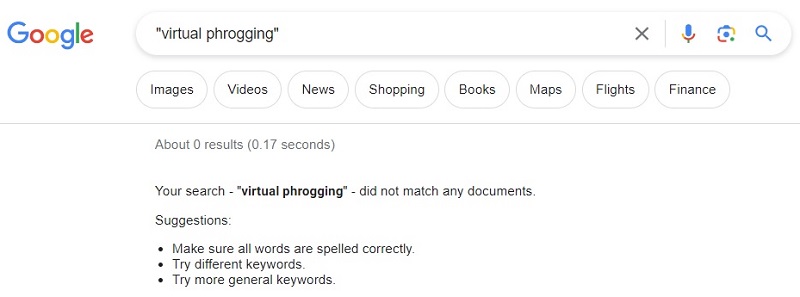
Crimes Related to Phrogging
The tentacles of phrogging can be easily envisioned when taking note of numerous criminal activities that are often connected or related to phrogging:
- House Squatting
- Trespassing
- Breaking & Entering
- Vandalism
- Burglary
- Utility Theft
- Stalking & Cyberstalking
- Spying & Cyberspying
- Identity Theft
- Bullying
- Creepy Crawling
With these tangential crimes in mind, we recommend further expanding the definition of phrogging to encompass any unauthorized use of person’s home home, property, or digital assets.
Emerging Examples of Phrogging
We take the position that you can still be a victim of phrogging without having an intruder physically living in your home. Here are a few pertinent examples that convey the pervasive threat of phrogging:
Utility Theft
Utility theft can occur without living in another persons home, but the unauthorized access and use of water or electricity, for example, would be the same “as if you were living in a property without permission“. For instance, an employee of a Los Angeles-area utility company recently confirmed with us that in the past year they have detected electrical utility theft between units within multifamily buildings (e.g. condos/apartments). The electrical theft was facilitated by illegally tapping into a neighbor’s electrical wires running within shared-walls.
Spying
A plethora of spy technology (e.g. devices and software for viewing, listening, or monitoring digital activities of others without permission) can further enable criminals to live virtually in another’s home completely unnoticed. We remember once reading a bathroom renovation article that revealed the disturbing story of new homeowners discovering a wireless spy camera within the walls of their bathroom. They had no idea how long it had been there, nor who could have placed it, nor how long they had been watched.
A similar example of bathroom spying was brought to court in Houston earlier this year, where the perpetrator, a shared-wall townhouse neighbor, placed a camera in the attic above a bathroom of his neighbor’s home.
Also see:
- How to Find a Hidden Camera Planted by Your Landlord, Airbnb Host, or Another Creep
- How to Discover Hidden Cameras Using the Fing App (also popular for an Airbnb or VRBO rental properties)
- People Discovering Being Recorded by Hidden Cameras & Microphones (Reddit Thread)
Creepy Crawling
Creepy Crawling was brought into the cultural lexicon by the murderous California-based Manson Family in the late 1960’s. Creepy crawling was the practice of secretly entering someone’s home and leaving subtle, yet disturbing traces of evidence that the sanctity of a victim’s home had been breached.

We believe that this twisted form of psychological voyeurism can extend to everyday occurrences anytime a home service “professional” accesses or views parts of one’s home without supervision or permission. The modern form of “creepy crawling” is especially possible in apartments and condominium buildings that grant unrestricted access to maintenance staff. Tenants and residents in multifamily communities need to know their rights and should strive to be on site whenever your home is being accessed by others.
Adequately protecting your home from these various types of intruders is crucial for maintaining security, as well as your mental well-being. It is essential to be vigilant and take necessary measures to prevent such incidents. By staying up to date on technology threats, understanding risks, being proactive, and implementing security measures, you can safeguard your home from this invasive and alarming crime.
Also see:
How Phrogging Differs from House Squatting
Phrogging and house squatting are terms associated with unauthorized habitation or presence in a property. While they might seem similar, there are crucial differences between the two in terms of intent, legal implications, and their impact on property owners.
Phrogging involves an individual secretly inhabiting a property without the knowledge or consent of the property owner. The person usually achieves this by blending in with the surroundings, and making it appear as if they belong there, when seen by neighbors or passersby.
On the other hand, squatting refers to the act of occupying an abandoned or unoccupied property without the owner’s permission. Some legally savvy squatters often intend to establish residency, asserting rights to the property over time. The threat of house squatters makes it especially important for remote landlords to hire local property managers to visit their properties in person regularly.
Phrogging differs from House Squatting in three key ways:
1. Purpose and Intent
Phrogging typically involves hiding or disguising oneself within a property temporarily, often for various reasons such as shelter or illegal activities. Squatting, however, involves establishing more permanent residency and potentially claiming legal rights to the property. Adept squatters are skilled at presenting an illusion of legal occupation by responsibly taking care of a property, especially in properties owned by absentee landlords.
2. Legal Implications
Phrogging is clearly illegal, constituting trespassing and potential invasion of privacy. In our opinion, a phrogger is a more dangerous version of a squatter, as a squatter does not break the personal sanctity of any resident, whereas a phrogger most certainly does.
Squatting, depending on the jurisdiction, may lead to legal battles, as squatters might try to establish adverse possession rights. This is especially applicable if the squatter once had legal status for the property in question.
3. Level of Intrusion
Phrogging is typically a short-term intrusion, where the individual aims to remain undetected for a brief period. Squatting involves a more extended and intentional presence, aiming for potential property rights.
Similarities
While distinct, phrogging and squatting share the commonality of unauthorized presence in a property. Both actions infringe upon the property owner’s rights and can cause significant emotional and financial distress.
Also see:
How Phrogging Happens
Phrogs often target temporarily unoccupied properties or nearby neglected structures to carry out their illegal occupation. Understanding how phrogging happens is essential in taking preventive measures against such intrusions. By being aware of this alarming phenomenon, homeowners and renters alike can better protect themselves and their properties from potential harm and ensure a sense of security in their own homes. Stay safe by staying informed and perceiving phrogging in broad terms.
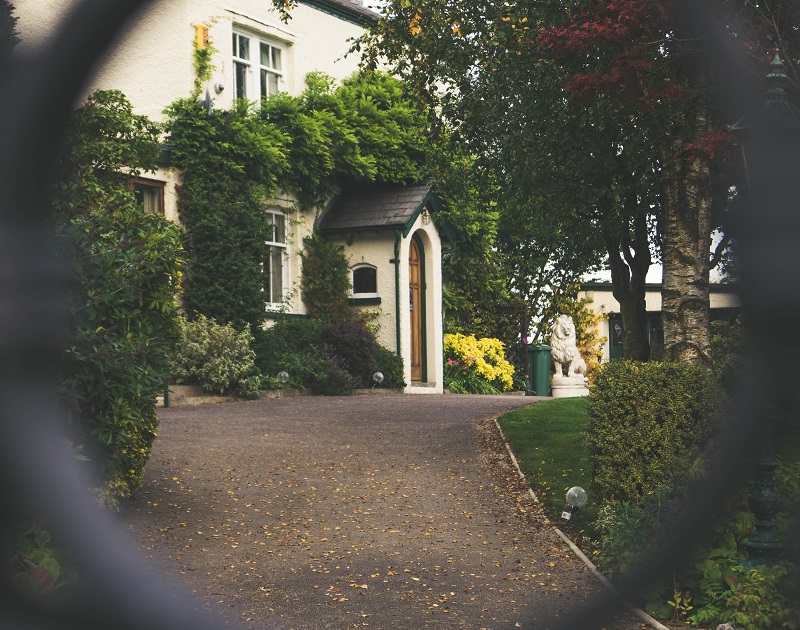
This act of illegal phrogging occupation or access can be committed for a wide range of motives, such as:
- Needing Free Shelter
- Avoiding Authorities
- Hiding Illegal Activities
- Engaging in Thrill Seeking
- Seeking Revenge
- Stalking a Resident
- Disregarding the Property Rights of Others
- Running Away without Financial Means
- Participating in Mentally-Imbalanced Voyeurism
Non-stalking phroggers are also not always strangers, as this confession reveals on Reddit where a recently laid off man phrogged the home of a former co-worker during the cold winter months. The initial break-in was especially easy as the phrogger knew where the victim hid his house key outside the front door. The display of an activity calendar in the kitchen was especially helpful for him to know when the home would be empty.
Phrogging Trends
Though there are no readily-available crime statistics on phrogging incidents, we did find information on the research conducted by the production team of Lifetime’s new documentary series “Phrogging: Hider in My House“. An exclusive interview conducted by Grunge with Jessica Everleth, the show’s executive producer, revealed the following insights:
- Producers discovered some 300 examples of phrogging during their research for the show
- Phrogging cases are often discovered only after “items disappear, only to later reappear”
- Most often “the homeowners and occupants feel like they’re going crazy”
- Sometimes phroggers target the home, while other times they target the occupant (e.g. phrogger-stalker scenario)
- Everleth found “it was surprising to hear how many people believed that they had a ghost rather than an intruder was living in their midst“
- Ample cases exist for the show as the premier season consisted of 10 phrogging cases, with hopes to be renewed for a second season
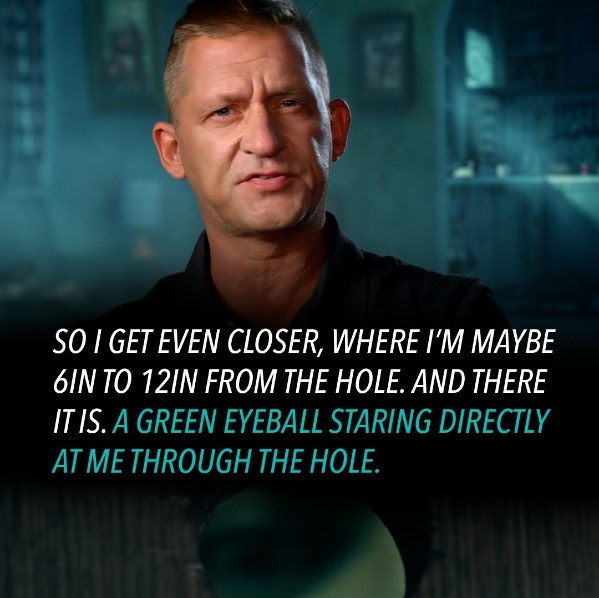
Image courtesy of Lifetime TV
Other trends that will likely increase phrogging incidents in coming years include:
- Rising levels of homelessness throughout the country
- High cost of housing throughout the country
- Weakening legal protection for property owners
- Soft sentencing of convicted phrogging offenders
- Romanticized portrayal of phrogging in pop cultural media outlets
- Increasing numbers of thrill seekers willing to break the law
- Ever-pervasive technology that can be used for nefarious deeds (e.g. spying, monitoring, breaking & entering, etc.)
- Increasing number of detached structures (e.g. ADUs, sheds, garages, studios, etc.)
- Travel returning to historic averages (i.e. more temporarily unoccupied homes)
- Increasing numbers of poorly managed and maintained properties (e.g. aging housing inventory; short-term rentals; absentee landlords; etc.)
Also see:
- How prevalent is phrogging, and is it on the rise or decline?
- Your Guide to Living Secretly in a Stranger’s Home (Evil Hacks by Lifehacker)
Signs that Your Home May Be at Risk of Being Phrogged
Recognizing the signs that your home may be at risk of phrogging is crucial for ensuring the safety and security of your property and loved ones.
Signs may include:
- Unusual Noises or Movements
- Missing or Moved Items
- Inexplicable Food Disappearances
- Changes in Utility Usage
- Strange Objects, Items or Artifacts
Unusual Noises or Movements in Your Home
Unusual noises or movements within your home, without any reasonable explanation, could potentially indicate the presence of a phrogger.
Hearing unfamiliar sounds like taps, footsteps or voices when your house is supposed to be empty can be an indication of a phrogging intruder. Additionally, unexpected movements of objects and doors opening or closing on their own might suggest the presence of a phrogger. By paying attention to these unusual occurrences, you can increase your chances of detecting phrogging in your own home. Stay vigilant and don’t hesitate to take necessary steps to protect yourself and your family from this invasive act.
“It was surprising to hear how many people believed that they had a ghost rather than an intruder was living in their midst.”
– Jessica Everleth, Executive Producer, Phrogging: Hider in My House
Missing or Moved Items in Your Home
Discovering inexplicably missing or misplaced items in your home can be a disconcerting experience. If you notice missing or moved items in your home, especially valuable possessions, it could be a sign of a phrogging incident. Phrogs may move belongings around to mark their presence or steal valuable items.
Remembering details on the location of your belongings is important in identifying any potential phrogging incidents. If you notice that items are missing or have been moved without explanation, it’s crucial to take proactive steps to ensure your safety and protect your home from further intrusion.
Inexplicable Food Disappearances
Inexplicably missing food items or rapidly eaten cakes, pies or ice cream can lead to intra-household spats. This scenario can also lead a member of the household to install a hidden camera to solve a missing food mystery once and for all. Sometimes the video evidence can be frightening, as the video below chronicles.
Changes in Utility Usage
Closely monitoring your monthly utility bills and corresponding usage metrics is critical for making sure your home is operating without any critical issues. Unusual spikes or usage pattens that cannot be explained are red flags that something is amiss.
The underlying cause could be from a range of issues, none of them good, such as:
- Leaks
- Inaccurate Meters or Measurement Methods
- Faulty Billing Calculations
- Excessive Phantom Power Usage
- Utility Theft by a Neighbor
- An In-House Intruder (AKA Phrogger)
Strange Objects, Items or Artifacts
If someone is secretly living in your home without your permission or knowledge, they will eventually leave an item out in the open to be discovered, whether purposefully or inadvertently. It is good practice to comfirm the ownership or origins of any unfamiliar items found inside your household or elsewhere on your property. This is especially true for active homes with many residents, especially large houses with several roommates, as it is easy for signs of a phrogger to go unnoticed.
How to Protect Your Home from Phrogging Intruders
Conducting regular home security checks is crucial for preventing phrogging intrusions. By checking for any signs of unauthorized entry, such as tampered locks or unusual disturbances, you can quickly identify potential phroggers. Installing security cameras and alarms can serve as effective deterrents and provide valuable evidence in the event of a phrogging incident. Additionally, keeping valuables out of sight or securing them in a safe can help minimize the risk of theft during a phrogging intrusion. Stay vigilant and take necessary precautions to protect your home from these invasive and dangerous intruders.
Here are steps to take to reduce the chances of being a victim of phrogging:
- Audit Your Utility Bills and Usage Metrics on a Monthly Basis
- Conduct Regular Home Security Checks
- Install Security Cameras and Alarms
- Consider Adopting a Dog
- Keep Valuable Belongings & Information Out of Sight
- Study Your Home Through the Eyes of a Phrog
- Consider Purchasing a Gun
Audit Your Utility Bills and Usage Metrics on a Monthly Basis
We list checking utility bills first, as every homeowner should do this as an important aspect of being a responsible homeowner and an effective property manager. Additionally, unusual usage spikes can be indicators of leaks, utility theft, defective meters, and yes, even a phrogger in your house.
Checking utility metrics for periods when your house is empty (e.g. after a vacation) is especially constructive as you can categorically rule out members of your household as being the cause of any usage spikes. This practice can also help identify sources of excessive phantom power (e.g. devices and appliances that use electricity when not in use, but plugged into a socket).
Closely monitoring your utility bills will help you detect any virtual phrogs (e.g. illegal access to your water, electricity, Internet access, cable service, streaming platforms, etc.). Again a virtual phrogger, or ghost phrogger, is someone remotely accessing any resources of your home or property, be they physical resources or digital assets, without your expressed permission.
Conduct Regular Home Security Checks
Regularly assessing the security of your home is vital in preventing phrogging incidents. By inspecting for signs of forced entry or unauthorized access, you can stay one step ahead of potential burglars. Ensure that all doors, windows, and entry points are secure to deter phroggers from targeting your property. Proactively staying on top of your home’s security significantly reduces the risk of phrogging intrusions. It’s crucial to make home security checks a regular part of your routine to protect your family and belongings.
Install Security Cameras and Alarms
Installing security cameras and alarms can provide an additional layer of protection against phrogging intruders. Visible security systems act as a deterrent, making your home less attractive to potential phroggers. The presence of security cameras can also capture crucial evidence in the event of a phrogging incident, which can aid in legal proceedings. By investing in security measures like a Ring camera and alarms, you are taking proactive steps to safeguard your home and protect yourself from the invasion of privacy that phrogging entails.
Consider Adopting a Dog
Any breed of dog will help to serve as a deterrent to phroggers given their heightened senses of smell and hearing. If a stranger is in the house, a dog’s acting up will serve as a warning to both you and the offending phrogger. Having a dog that is often seen and heard outside should be enough for any prospective phrogger to take a hard pass on your house.

Keep Valuable Belongings & Information Out of Sight
Keeping your valuable items and information out of sight or stored in a safe is an essential precaution to minimize the risk of theft during a phrogging incident. By securely locking away expensive belongings and important documents, you are reducing the incentive for phroggers to target your home. This proactive measure can help protect your valuables and mitigate potential losses resulting from a phrogging intrusion. Remember, taking precautions to safeguard your possessions is crucial in ensuring the security of your home and the well-being of your family.
Study Your Home Through the Eyes of a Phrog
A disturbing post on Reddit provides this “expert” advice to runaways considering phrogging as a short-term living arrangement:
“When choosing a home to target, look for homes that are remote or under-occupied, well-hidden or secluded, and in need of repairs or renovations. Avoid homes with security systems as they are much harder to break into and more likely to be monitored.”
The post goes on to describe how “selecting the right home to phrog is key to having a successful experience“.
Here are a few highlights:
- Homes with an attic, crawlspace or basement are desirable as these internal spaces are highly secure, dampen noise, and are rarely inspected by owners
- Properties without security systems are the best places to check out
- Homes in highly populated areas are attractive as it is easier for a phrog to go unnoticed
- Homes in remote isolated areas are also attractive as there are fewer potential witnesses
- Homes in remote areas, however, are challenging as homeowners are more likely to notice differences nearby, such as footprints and other signs of intrusion
- Homes with security systems are “pretty much a no-go“
- Phrogging on apartments is not recommended as they present many challenges to a phrogger (e.g. entering, hiding, exiting)
Tips on not being detected include:
- The best times to leave are usually when the homeowner is at work, or just out in general
- Always take food from the back of the fridge
- Always remember to clean up
- Never leave at night when the homeowner is home
Consider Purchasing a Gun
If the thought of a stranger entering your home terrifies you, let alone living there, it may be time to consider purchasing a gun for your protection. As this is an enormous responsibility, the first step to gun ownership is education and training. Start the process now so that you can grow your comfort level, skills and knowledge at your own pace. By also learning in a group setting you can meet future shooting partners that will make the overall experience more enjoyable, encouraging and productive.
Legal Recourse for Victims of Phrogging
Victims of phrogging can seek legal recourse against the intruders who invade their homes. Trespassing laws provide protection against this unlawful activity, allowing victims to take legal action. The phroggers themselves can face penalties for their actions, as they are violating trespassing laws. In addition, victims may be entitled to compensation for any damages caused by the phrogging incident. To fully understand their rights and explore their legal options, homeowners should consult with a legal professional who specializes in these types of cases.
Trespassing Laws and Penalties
Trespassing laws vary depending on the jurisdiction, but in general, they prohibit unauthorized entry into someone else’s property. The penalties for trespassing can range from fines to imprisonment, depending on the seriousness of the offense.
Since phrogging is considered a form of trespassing, this illegal act can also result in criminal charges, including felony charges. It is important for property owners to familiarize themselves with their local trespassing laws in order to know their rights and how this type of crime is typically prosecuted. Reporting incidents of phrogging to law enforcement can help ensure that the perpetrators are held accountable and serve as a deterrent to other potential perpetrators.
Besides trespassing, phroggers can also be charged with the following crimes: breaking and entering; burglarly; stalking; harassment; vandalism; and more.
Frequently Asked Questions about Phrogging
Here are commonly asked questions pertaining to topics related to phrogging in this FAQ section.
- What is phrogging?
- Is phrogging a real crime?
- What is the difference between phrogging and squatting?
- Where do phroggers hide?
- Where does the term “phrogging” come from?
- What kind of people are more likely to participate in phrogging?
- How prevalent is phrogging, and is it on the rise or decline?
- What are some examples of famous phrogging cases?
What is phrogging?
Phrogging refers to the act of squatting in someone else’s home without their knowledge or permission. Intruders gain access through unlocked doors, windows, or posing as service providers. Protect your home by securing all entry points and immediately contacting authorities if you suspect phrogging.
Is phrogging a real crime?
Phrogging is indeed a real crime. It involves entering someone’s home without their knowledge and living there secretly. This act is illegal and considered a form of trespassing. To protect your home from phrogging, secure all entry points and stay vigilant for any suspicious activity.
What is the difference between phrogging and squatting?
Phrogging and squatting may seem similar, but there are key differences. Phrogging involves someone secretly living in another person’s home without permission, while squatting typically occurs in abandoned or unoccupied properties. While both can lead to legal issues and property damage, phrogging is specific to unauthorized entry into an occupied property.
Where do phroggers hide?
Phroggers hide in various places within your home, such as:
- Crawl Spaces
- Attics
- Basements
- Garages
- Unused Rooms
- Closets
- Sheds
- Guest Houses
- Other Types of Detached Structures (e.g. unused ADUs, pool houses)
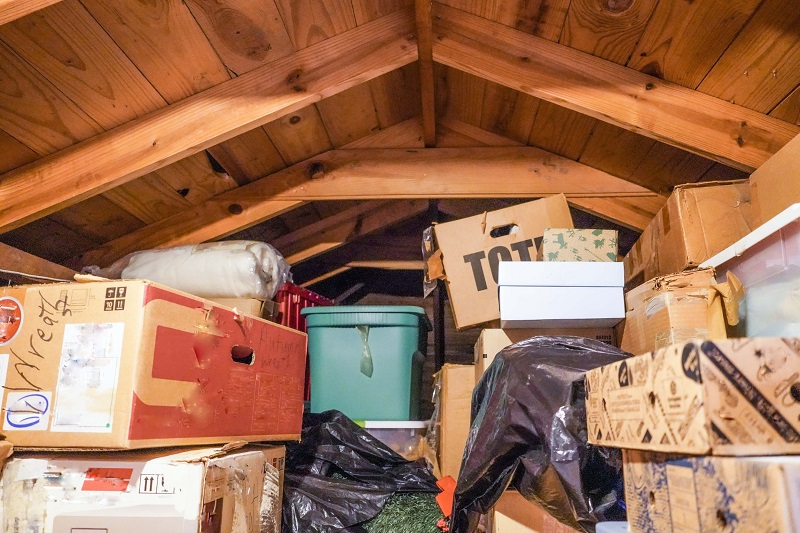
Phrogs can also utilize ventilation systems and crawl spaces to move around undetected. Regularly checking your home and sealing off potential entry points is crucial to protect against these crafty intruders.
Where does the term “phrogging” come from?
The term “phrogging” is derived from the word “frog” and refers to the tendency of habitual phroggers to “leap frog” from property to property in order to evade detection. Though the term “phrogging” is relatively new, the practice has been around for many years. While it is believed to have originated in the United States, phrogging has unfortunately now spread to other countries as well.
A person who commits an act of phrogging is referred to as a phrogger or phrog.
The “Broker in Insurance” website credits John Stevens, the creator of the 2006 YouTube series “Living with Strangers“, for coining the terms phrogging and phrogs. According to Nolo, the word phrogging has not appeared in any traditional dictionaries as of 2022 and is not considered to be a legal term, whereas the term squatting has been for many years.
What kind of people are more likely to participate in phrogging?
Individuals who are more likely to participate in phrogging include homeless individuals, runaways, and mentally unstable persons seeking a safe place to stay. It can also be done by habitual criminals looking for a secluded base of operations. Protect your home by installing security systems and being vigilant about unknown individuals on your property.
Keep in mind that phroggers can also be known by victims (e.g. past boyfriends or girlfriends, former co-workers, friends, etc.) and even be current or former family members (e.g. ex-husbands).
How prevalent is phrogging, and is it on the rise or decline?
The prevalence of phrogging is difficult to determine as there is no clear data available. Since phrogging is not currently “neatly” categorized in current crime statistics, tabulation of similar and related crime statistics will need to be processed and analyzed to present initial estimates.
When phrogging is defined broadly to include virtual phrogging, utility theft, and spying, we definitely believe phrogging will continue to be on the rise for many years to come. Even though narrowly-defined phrogging may not be a common crime, it still poses a threat to homeowners.
What are some examples of famous phrogging cases?
With increasing interest in phrogging largely due to new TV series and movies, several websites have been tabulating collections of interesting real-life examples of phrogging. Here are a just a few:
- “Phrogging: Hider in My House” Lifetime TV Episode Guide
- 9 Real Phrogging Cases (2023) You Ought to Know
- Ten Creepy Phrogging Incidents Faced by Homeowners
- Top 5 Five Horrible Phrogging Incidents From The United States
- 6 Celebrities Who Have Been Victims of Phrogging
Phrogging Videos
Here are a few videos that give a good sense of what it’s like to deal with a phrogging situation in your home.
Phrogging Victims Share Their Stories from “Phrogging: Hider in My House”
Houston Man Finds Woman Living in Attic
Couple Catches Neighbor in Attic: ‘He Was Waiting for the Creep Show’
Closing Comments
Phrogging intruders pose a significant threat to the security and privacy of your home. It is essential to be aware of the signs that indicate your home may be at risk and take proactive measures to protect yourself and your loved ones. Regular home security checks, installing security cameras and alarms, and keeping valuable possessions and information out of sight or in a safe are key steps you can take to safeguard your home.
In the unfortunate event that you become a victim of phrogging, it’s important to know your legal rights and seek appropriate recourse. Remember, your home should always be a sanctuary, and by staying vigilant and taking necessary precautions, you can ensure it remains a safe haven for you and your family.
Recommended Homeowner Security & Consumer Protection Articles
- How to Make Your Home Entrances & Deliveries Safe With Technology
- Informed Delivery: How to Preview Your Postal Mail Online for Free
- 10 Conflicts of Interest Every Homeowner Should Know
- Why You Should Never Loan Your Ladder to a Contractor
- Important Must-Have Legal Documents for Homeowners
- Signs of a Bad Contractor Before You Sign a Contract
- Best Online Legal Services for Homeowners & Property Owners
- Never Heard of Check Washing & Still Mailing Checks? Read This.
- How to Keep Your Child Safe Online at Home
- Other Homeowner-Related Crimes
- Related Topics: Protection & Safety | Consumer Rights | Home Inspections | Hiring Contractors
| Purgula is reader-supported. When you click on links to other sites from our website, we may earn affiliate commissions, at no cost to you. If you find our content to be helpful, this is an easy way for you to support our mission. Thanks! Learn more. |

